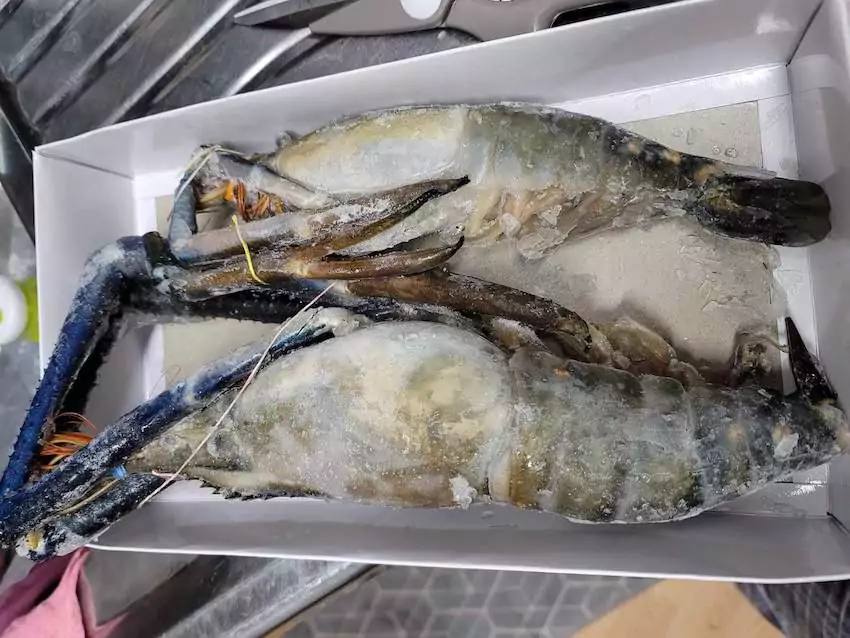When eating shrimp, most people only consume the meat and discard the rest. However, did you know that some of the organs of shrimp are edible and can be quite nutritious?
As someone who enjoys exploring different types of food, I decided to take a closer look at the topic of edible and inedible shrimp organs.
Do shrimp have organs?
Yes, shrimp, like other animals, have organs. Shrimp are crustaceans whose bodies comprise various organs and systems necessary for survival. These organs include:
- Digestive System: Shrimp have a simple digestive system that includes a stomach, intestine, and associated digestive glands. They use this system to process and extract nutrients from their food.
- Respiratory System: Shrimp have gills that enable them to extract oxygen from water. These gills are vital for their respiration.
- Circulatory System: Shrimp have a circulatory system that includes a heart-like structure called the dorsal heart, which pumps blood (hemolymph) throughout their bodies. Hemolymph transports oxygen and nutrients to cells and carries waste products away.
- Nervous System: Shrimp have a nervous system with a brain and various sensory organs that help them respond to their environment.
- Excretory System: Shrimp have excretory organs that help eliminate waste products from their bodies.
- Reproductive System: Shrimp have reproductive organs that allow them to reproduce and pass on their genetic material.
- Muscular System: Shrimp have muscles that enable them to move, swim, and carry out various activities.
- Sensory Organs: Shrimp have sensory organs such as antennae and compound eyes that help them detect their surroundings and find food.
- Protective Structures: Shrimp also have protective structures, like their exoskeleton (hard outer shell), which provides support and protection.
Edible Shrimp Organs
As a seafood lover, I have always been curious about which parts of the shrimp are edible and which ones are not. This section will discuss the different edible shrimp organs and their nutritional value.
Meat
The most commonly consumed part of the shrimp is its meat. Shrimp meat is low in fat and calories but high in protein, making it a healthy and delicious choice. It is also a good source of vitamins and minerals, including vitamin B12, phosphorus, and selenium.
Head Meat
The meat inside the head of the shrimp is also edible and often considered a delicacy in some cultures. It is rich in flavor and can add depth to soups and stews. However, it is important to note that the head meat can be difficult to extract and may not be worth the effort for some.
Eggs
Shrimp eggs, also known as roe, are edible and can be found in the female shrimp. They are small, orange-colored sacs that can be eaten raw or cooked. Shrimp roe is high in protein and omega-3 fatty acids, making it a healthy addition to your diet.
Tomalley
The tomalley, or the green gland or liver, is a soft, green substance in the shrimp’s body. It is edible and often considered a delicacy in some cultures. However, it is important to note that the tomalley can contain high toxins, such as mercury and PCBs, and should be consumed in moderation.
| Edible Shrimp Organs | Nutritional Value |
|---|---|
| Meat | Low in fat and calories, high in protein, vitamin B12, phosphorus, and selenium |
| Head Meat | Rich in flavor, can be used to add depth to soups and stews |
| Eggs | High in protein and omega-3 fatty acids |
| Tomalley | Soft, green substance, can contain high levels of toxins |
Sources:
- Shrimp Nutritional Information
- Shrimp Roe: Nutrition, Benefits, and Culinary Uses
- Is Shrimp Safe to Eat? Nutrition, Benefits, and Concerns
Inedible Shrimp Organs

As a seafood lover, I have always been fascinated by the variety of edible and inedible parts of shrimp. Here, I will discuss the inedible parts of shrimp unsuitable for human consumption.
Exoskeleton
The exoskeleton of a shrimp is the hard outer shell that protects the shrimp’s body. It is made of chitin, a type of carbohydrate that is indigestible for humans. The exoskeleton is removed during the processing of shrimp, and it is not consumed. However, it is used to make chitin, which has various industrial and medical applications.
Gills
Shrimp have gills, which are responsible for extracting oxygen from the water. The gills are not edible and are removed during the processing of shrimp. They are unsuitable for human consumption because they contain harmful bacteria and toxins.
Eyestalks
Shrimp have eyestalks, the protruding structures on either side of their heads. The eyestalks are not edible and are usually removed during processing. However, they are used to make eyestalk extract, which produces various drugs and cosmetics.
Intestines
The intestines of shrimp are not edible because they contain waste material and harmful bacteria. They are removed during processing, and the remaining meat is washed thoroughly to remove any remaining waste material.
Sources:
- Anatomy of a Shrimp/Crawfish – University of Florida
- Chapter 3 and 7 Flashcards | Quizlet
- Role of hormones in shrimp growth, reproduction – Global Aquaculture Alliance
Uses of Edible Shrimp Organs
As a seafood lover, I have always been fascinated by the various parts of shrimp that are edible. Shrimp are not only delicious but also a great source of nutrition. In this section, I will explore edible shrimp organs’ culinary applications and nutritional value.
Culinary Applications
Shrimp are a versatile ingredient that can be used in various dishes. The meat of the shrimp is the most commonly consumed part, but the organs are also edible and can add flavor and texture to dishes. Here are some examples of how edible shrimp organs can be used in cooking:
- Shrimp heads: Shrimp heads are often used to make broth or stock. The heads contain a lot of flavor and can add depth to soups, stews, and sauces. They can also be roasted or fried and eaten as a crunchy snack.
- Shrimp shells: Shrimp shells can be used to make a flavorful stock or to add flavor to rice dishes. They can also be ground into a powder and used as a seasoning.
- Shrimp roe: Shrimp roe, or eggs, are a delicacy in many cultures. They can be eaten raw or cooked and are often used as a topping for sushi or garnish.
Nutritional Value
In addition to their culinary applications, edible shrimp organs are also a great source of nutrition. Here are some of the key nutrients found in shrimp organs:
| Nutrient | Amount per 100g |
|---|---|
| Protein | 20g |
| Omega-3 fatty acids | 0.4g |
| Iron | 2.8mg |
| Zinc | 1.2mg |
These nutrients are important for maintaining a healthy diet. Protein is essential for building and repairing tissues in the body, while omega-3 fatty acids are important for brain health. Iron and zinc are important minerals needed for various bodily functions.
Uses of Inedible Shrimp Organs
As a seafood enthusiast, I have always been intrigued by the different shrimp parts that can be consumed. However, not all shrimp organs are edible. In this section, I will discuss the uses of inedible shrimp organs.
Industrial Applications
Shrimp waste, including inedible organs, can be used in various industrial applications. The chitin in shrimp shells can be extracted and used to produce chitosan. This biopolymer has a wide range of applications.
Chitosan can be used to produce water treatment chemicals, wound dressings, and as a food preservative.
Shrimp waste can also be used to produce astaxanthin. This red pigment is used in the production of cosmetics and animal feed. Astaxanthin is a potent antioxidant and has been shown to have numerous health benefits.
Environmental Applications
Shrimp waste can also be used in environmental applications. Shrimp shells and other inedible organs can produce chitinase, an enzyme that breaks down chitin. Chitinase can be used to remove chitin from wastewater, reducing the environmental impact of shrimp processing.
Shrimp waste can also be used as a fertilizer. The high nitrogen content of shrimp waste makes it an excellent fertilizer for plants. Shrimp waste can also improve soil quality, containing essential minerals and nutrients.
In conclusion, inedible shrimp organs have a range of industrial and environmental applications. From producing chitosan and astaxanthin to improving soil quality and reducing the environmental impact of shrimp processing, shrimp waste has numerous uses beyond the dinner table.
Commonly Asked Questions
While researching edible and inedible shrimp organs, I came across some frequently asked questions. Here are some of the most common ones:
The “vein” in a shrimp is actually its digestive tract. Some people choose to remove it before eating the shrimp, while others leave it in. It is safe to eat, but some people find it unappetizing.
Yes, some shrimp organs are actually quite nutritious. For example, shrimp heads contain a lot of omega-3 fatty acids, which are good for your heart and brain. Shrimp also contain a lot of protein, which can help you build and repair muscle tissue.
If you want to eat shrimp organs, it’s important to clean them thoroughly first. Rinse them under cold water and remove any visible dirt or debris. You can then cook them in a variety of ways, such as boiling, frying, or grilling. Some people also like to pickle or ferment shrimp organs for added flavor.





Leave a Reply
You must be logged in to post a comment.